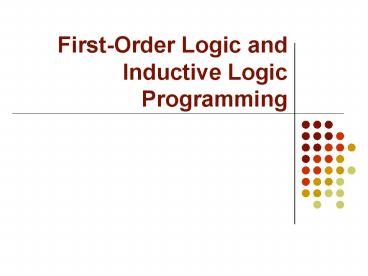First-Order Logic and Inductive Logic Programming - PowerPoint PPT Presentation
Title:
First-Order Logic and Inductive Logic Programming
Description:
First-Order Logic and Inductive Logic Programming Overview First-order logic Inference in first-order logic Inductive logic programming First-Order Logic Constants ... – PowerPoint PPT presentation
Number of Views:156
Avg rating:3.0/5.0
Title: First-Order Logic and Inductive Logic Programming
1
First-Order Logic and Inductive Logic Programming
2
Overview
- First-order logic
- Inference in first-order logic
- Inductive logic programming
3
First-Order Logic
- Constants, variables, functions, predicatesE.g.
Anna, x, MotherOf(x), Friends(x, y) - Literal Predicate or its negation
- Clause Disjunction of literals
- Grounding Replace all variables by
constantsE.g. Friends (Anna, Bob) - World (model, interpretation)Assignment of
truth values to all ground predicates
4
Example Friends Smokers
5
Example Friends Smokers
6
Inference in First-Order Logic
- Traditionally done by theorem proving(e.g.
Prolog) - Propositionalization followed by model checking
turns out to be faster (often a lot) - PropositionalizationCreate all ground atoms and
clauses - Model checking Satisfiability testing
- Two main approaches
- Backtracking (e.g. DPLL)
- Stochastic local search (e.g. WalkSAT)
7
Satisfiability
- Input Set of clauses(Convert KB to conjunctive
normal form (CNF)) - Output Truth assignment that satisfies all
clauses, or failure - The paradigmatic NP-complete problem
- Solution Search
- Key pointMost SAT problems are actually easy
- Hard region Narrow range ofClauses / Variables
8
Backtracking
- Assign truth values by depth-first search
- Assigning a variable deletes false literalsand
satisfied clauses - Empty set of clauses Success
- Empty clause Failure
- Additional improvements
- Unit propagation (unit clause forces truth value)
- Pure literals (same truth value everywhere)
9
The DPLL Algorithm
if CNF is empty then return true else if CNF
contains an empty clause then return
false else if CNF contains a pure literal x then
return DPLL(CNF(x)) else if CNF contains a
unit clause u then return
DPLL(CNF(u)) else choose a variable x that
appears in CNF if DPLL(CNF(x)) true then
return true else return DPLL(CNF(x))
10
Stochastic Local Search
- Uses complete assignments instead of partial
- Start with random state
- Flip variables in unsatisfied clauses
- Hill-climbing Minimize unsatisfied clauses
- Avoid local minima Random flips
- Multiple restarts
11
The WalkSAT Algorithm
for i ? 1 to max-tries do solution random
truth assignment for j ? 1 to max-flips do
if all clauses satisfied then
return solution c ? random unsatisfied
clause with probability p
flip a random variable in c else
flip variable in c that maximizes
number of satisfied clauses return failure
12
Rule Induction
- Given Set of positive and negative examples of
some concept - Example (x1, x2, , xn, y)
- y concept (Boolean)
- x1, x2, , xn attributes (assume Boolean)
- Goal Induce a set of rules that cover all
positive examples and no negative ones - Rule xa xb ? y (xa Literal, i.e., xi
or its negation) - Same as Horn clause Body ? Head
- Rule r covers example x iff x satisfies body of r
- Eval(r) Accuracy, info. gain, coverage, support,
etc.
13
Learning a Single Rule
head ? y body ? Ø repeat for each literal x
rx ? r with x added to body
Eval(rx) body ? body best x until no x
improves Eval(r) return r
14
Learning a Set of Rules
R ? Ø S ? examples repeat learn a single rule
r R ? R U r S ? S - positive
examples covered by r until S contains no
positive examples return R
15
First-Order Rule Induction
- y and xi are now predicates with argumentsE.g.
y is Ancestor(x,y), xi is Parent(x,y) - Literals to add are predicates or their negations
- Literal to add must include at least one
variablealready appearing in rule - Adding a literal changes groundings of
ruleE.g. Ancestor(x,z) Parent(z,y) ?
Ancestor(x,y) - Eval(r) must take this into accountE.g.
Multiply by positive groundings of rule
still covered after adding literal

